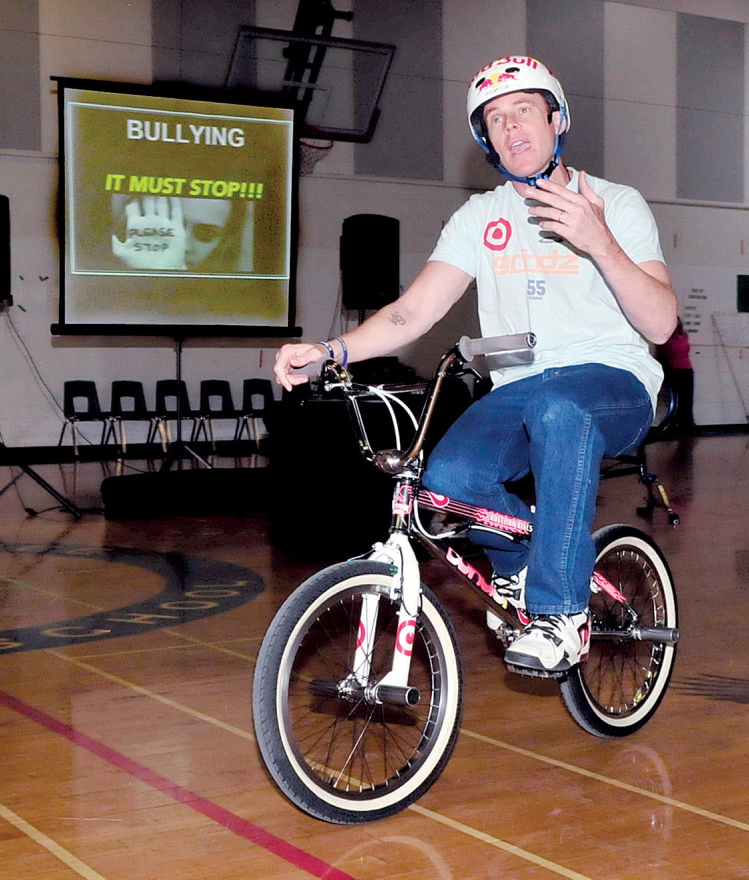Blake Marden, 14, knows bullies.
Back when he was in elementary school, they used to exclude him from their playground games.
At some point, fearing rejection, he stopped asking to join in, he said Monday after attending an antibullying event featuring X Games medalist Kevin Robinson at Messalonskee Middle School.
Marden told himself he didn’t want to talk to the bullies, but the truth was, he did.
“They were the boys, you know, the cool guys,” he said.
Today, Blake has grown into a young man whose sense of self worth isn’t tied up in the opinions of those who mistreat an offer of friendship.
But a recent state survey shows that, for the first time, the majority of Maine’s middle schoolers report being the subject of taunts, jeers and even physical attacks.
Bullying is at the center of a battle in Maine.
On one side of the battle, state legislators, the Department of Health and Human Resources, educators, parents and the Department of Education have all stepped up antibullying efforts under a new state law targeting a set of behaviors that can have serious consequences for victims.
On the other side of the battle are the schoolyard bullies, who seem determined to keep making fun of their peers.
So far, the bullies are winning.
The Maine Integrated Youth Health Survey, based on 63,000 student responses, found that in 2013, 51.6 percent of middle school students reported they’d been bullied, up from 48.1 percent in 2011, an increase the authors found to be statistically significant.
The survey, given every odd year since 2009, asks students in grades five through 12 about a variety of health factors, including alcohol and drug use, seatbelt use, food choices, thoughts of suicide and bullying.
The numbers for central Maine counties show similar increases.
In Kennebec County, the percentage of middle school students reporting bullying increased from 49.3 percent in 2011 to 51.3 percent in 2013.
In Waldo County, the percentage increased from 53.3 percent in 2011 to 55.5 percent in 2013.
In Somerset County, the percentage increased from 43.2 percent to 52.5 percent. This sounds like a lot, but because county numbers are based on a much smaller sample size than the state as a whole, there is less confidence in the numbers, and so the report’s authors don’t consider it to be a statistically significant increase.
In Franklin County, as in Washington, Hancock, and Knox counties, the survey’s response rate was too low for numbers to be reported at the county level.
The most-bullied peer group was girls aged 14 or older; in Kennebec County, 63 percent reported they’d been bullied.
Among fifth and sixth graders, the survey found the number of students who reported being bullied on school property increased from 45.4 percent in 2011 to 47.2 percent in 2013. The number of fifth and sixth graders who reported being bullied away from school property increased from 36.5 percent to 37.1 percent. In both cases, the survey’s authors found that the change was not statistically significant.
Among high schoolers, the number of students who reported having been bullied in the past 12 months increased from 24 percent in 2011 to 25.8 percent in 2013, a change the survey’s authors again found was not statistically significant.
Public response
Interest in anti-bullying strategies seems to be increasing.
Parents have called for more to be done about the problem of bullying, fueled in part by high-profile cases in which teen suicides have been associated with bullying. The family of 13-year-old Kitty McGuire, a Troy teen who took her own life in March, believes bullying was a factor in her death, a belief disputed by police investigators.
One step the state has taken to control bullying was new legislation, “An Act to Prohibit Bullying and Cyberbullying in Schools,” which Gov. Paul LePage signed into law in 2012.
Under the law, the state created and disseminated a model antibullying policy for school districts to adapt or adopt.
The 2012 law requires schools to document instances of bullying and what, if any, of a wide range of administrative responses were taken.
For example, a school might report that administrators responded in a case by meeting with the victim and the perpetrator, contacting the parents of both, and also referring the case to law enforcement or another outside agency.
The data will be reported to the state for the first time in June, and the state will compile the information and report it in aggregate form, probably in August or September, according to Samantha Warren, spokeswoman for the state Department of Education.
The survey’s purpose is to help direct resources for prevention and program planning and is a collaboration of Maine’s departments of Education and Health and Human Services.
Warren said the data in the report should help local communities see where they stand in relation to others in the state and will also “provide an opportunity for conversations about local policies and practices regarding bullying and bullying response in schools.”
Schools stepping up
Gary Smith, superintendent at Oakland-based Regional School Unit 18, said bullying can be a sensitive, complex issue that carries its own set of challenges.
The district sees accusations of bullying each year, Smith said.
Bullying is a component of school safety, one of the district’s top priorities for the current school year.
If anyone reports being bullied in any of the district’s schools in Belgrade, China, Oakland, Sidney and Rome, administrators launch an investigation.
“In many ways, it parallels affirmative action in that if any student or employee believes bullying has occurred, we need to address things,” he said.
But in some cases, Smith said, students are using bully as a label to describe others who might simply be expressing a valid opinion.
“The gotcha is that some folks now may call something bullying even if it is only an argument, disagreement or minor confrontation,” Smith said.
The school is also taking a preventive approach, Smith said, by using curriculum to teach and model tolerance, acceptance, teamwork and collaboration.
As part of the antibullying push, the Department of Education recently hired a new coordinator to lead the state’s bullying prevention efforts, announcing on Dec. 31 that the first person to fill the post is Stephanie Galeucia, who worked for the Maine Department of Health and Human Services Office of Adults with Disabilities for five years and has also served as assistant principal at Noble Middle School in Berwick.
Galeucia will use the new survey data to help her decide how best to support antibullying efforts in schools, Warren said.
Anti-bully acrobatics
One tangible outcome of all of the antibullying rhetoric is the introduction of programming to encourage responsible behavior and to discourage bullying.
To that end, extreme athlete Kevin Robinson sat on a BMX bicycle wearing jeans and a T-shirt festooned with sponsor logos in the gym at Messalonskee Middle School early Monday afternoon.
In front of him, the bleachers overflowed with hundreds of screaming middle school students, overawed by Robinson’s bike skills.
He has pushed competitive extreme bike tricks to the absolute limit, netting himself 10 medals in the annual X Games competition. In the process, he set a world record for height, having once shot up 27 feet above the upper edges of a 27-foot high ramp for a total unrivaled height attainment of 54 feet in the air on a bicycle.
Robinson’s most prominent logo, front and center on his helmet, was for Red Bull, ironic given that drinking the caffeinated beverage is another unhealthy behavior targeted in the state’s youth health survey.
Still, he delivered a nonstop series of positive messages to the students in between video footage and live performances of death-defying tricks performed by himself and two assistants on a ramp in the gym.
“It is not okay to be a bully,” he said at one point. “It’s that simple.
He said he remembered his own childhood when, as a scrawny kid with an obsessive love of bicycles, he was an easy target for bullies.
He urged the kids not to support bullying, even passively.
“Bullies need an audience,” he said. “People who will laugh without getting involved. I want you to stop being bystanders and start being upstanders. Stand up and ask them to stop. If you’re not comfortable asking them to stop, ask an adult to ask them to stop.”
In the crowd, Blake Marden, who says he’s not bullied any more, watched Robinson from the bleachers. He sat with Meghan McQuillan, Addison Littlefield, Percy Carey and Sadie Colby, four other students who are not only his friends, but also members of the Student Leadership team, a group that works to improve the school’s environment in part by addressing bullies.
During previous assemblies, they have acted out the role of bullies, victims, bystanders and upstanders to provide positive models to their peers.
At times, they have acted out the roles in real life.
After Robinson finished his presentation, the students concluded that it had been a great success. The bike stunts, which included one in which Robinson jumped over five teachers, nervously lying prostrate on the floor, had engaged them and their classmates, the students said.
Addison said students who are bullied will grow up with lowered self-esteem, which could limit their ability to interview for a job.
“You have to be confident to talk to them and get hired,” she said.
Meghan said her own father and another friend of hers were both bullied because they enjoyed dancing.
Still, she said, bullies need to be not only confronted, but understood.
“Bullies do it to get their own anger out,” she said. “Usually, they’ve been bullied themselves.”
Matt Hongoltz-Hetling — 861-9287 mhhetling@centralmaine.com Twitter: @hh_matt
Send questions/comments to the editors.





Success. Please wait for the page to reload. If the page does not reload within 5 seconds, please refresh the page.
Enter your email and password to access comments.
Hi, to comment on stories you must . This profile is in addition to your subscription and website login.
Already have a commenting profile? .
Invalid username/password.
Please check your email to confirm and complete your registration.
Only subscribers are eligible to post comments. Please subscribe or login first for digital access. Here’s why.
Use the form below to reset your password. When you've submitted your account email, we will send an email with a reset code.